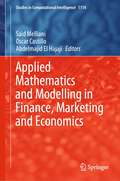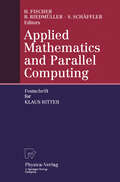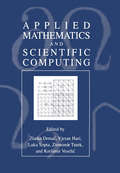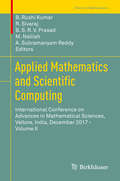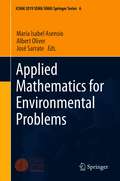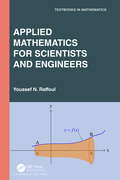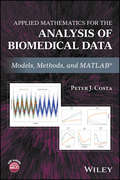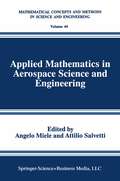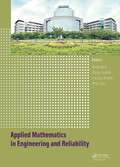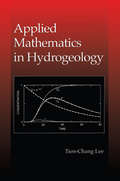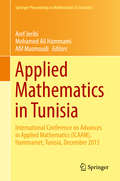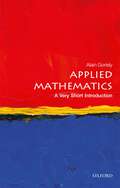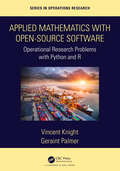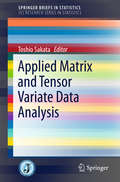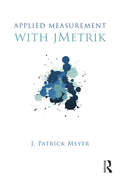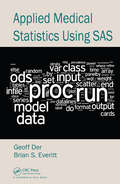- Table View
- List View
Applied Mathematics and Modelling in Finance, Marketing and Economics (Studies in Computational Intelligence #1114)
by Said Melliani Oscar Castillo Abdelmajid El HajajiThis book offers a comprehensive overview of the latest advancements in the field of applied mathematics as it relates to finance, marketing, and economics. It covers a range of topics including the effective utilization of applied mathematics and mathematical modeling in finance, economics, and marketing. Additionally, it explores the intersection between applied mathematics and practical applications in various scientific fields. The book targets a multidisciplinary audience, fostering the exchange of diverse ideas and showcasing the broad appeal of different subjects. It delves into recent developments in areas such as mathematical modeling in finance, mathematical modeling in marketing, the modeling of financial and economic fundamentals (e.g., interest rates, asset prices), market behavior modeling, modeling market imperfections, pricing financial derivative securities, hedging strategies, numerical methods, and financial engineering. The book features selected contributions presented at the first edition of the International Conference in Applied Mathematics to Finance, Marketing and Economics, which took place at the National School of Commerce and Management in El Jadida, Morocco, from November 26 to 27, 2020.
Applied Mathematics and Parallel Computing: Festschrift for Klaus Ritter
by Herbert Fischer Bruno Riedmüller Stefan SchäfflerThe authors of this Festschrift prepared these papers to honour and express their friendship to Klaus Ritter on the occasion of his sixtieth birthday. Be cause of Ritter's many friends and his international reputation among math ematicians, finding contributors was easy. In fact, constraints on the size of the book required us to limit the number of papers. Klaus Ritter has done important work in a variety of areas, especially in var ious applications of linear and nonlinear optimization and also in connection with statistics and parallel computing. For the latter we have to mention Rit ter's development of transputer workstation hardware. The wide scope of his research is reflected by the breadth of the contributions in this Festschrift. After several years of scientific research in the U.S., Klaus Ritter was ap pointed as full professor at the University of Stuttgart. Since then, his name has become inextricably connected with the regularly scheduled conferences on optimization in Oberwolfach. In 1981 he became full professor of Applied Mathematics and Mathematical Statistics at the Technical University of Mu nich. In addition to his university teaching duties, he has made the activity of applying mathematical methods to problems of industry to be centrally important.
Applied Mathematics and Scientific Computing
by Zlatko Drmac Vjeran Hari Luka Sopta Zvonimir Tutek Kresimir VeselicProceedings of the second conference on Applied Mathematics and Scientific Computing, held June 4-9, 2001 in Dubrovnik, Croatia. The main idea of the conference was to bring together applied mathematicians both from outside academia, as well as experts from other areas (engineering, applied sciences) whose work involves advanced mathematical techniques. During the meeting there were one complete mini-course, invited presentations, contributed talks and software presentations. A mini-course Schwarz Methods for Partial Differential Equations was given by Prof Marcus Sarkis (Worcester Polytechnic Institute, USA), and invited presentations were given by active researchers from the fields of numerical linear algebra, computational fluid dynamics , matrix theory and mathematical physics (fluid mechanics and elasticity). This volume contains the mini-course and review papers by invited speakers (Part I), as well as selected contributed presentations from the field of analysis, numerical mathematics, and engineering applications.
Applied Mathematics and Scientific Computing: International Conference on Advances in Mathematical Sciences, Vellore, India, December 2017 - Volume II (Trends in Mathematics)
by B. Rushi Kumar R. Sivaraj M. Nalliah A. Subramanyam Reddy B. S. PrasadThis volume is the first of two containing selected papers from the International Conference on Advances in Mathematical Sciences (ICAMS), held at the Vellore Institute of Technology in December 2017. This meeting brought together researchers from around the world to share their work, with the aim of promoting collaboration as a means of solving various problems in modern science and engineering. The authors of each chapter present a research problem, techniques suitable for solving it, and a discussion of the results obtained. These volumes will be of interest to both theoretical- and application-oriented individuals in academia and industry.Papers in Volume I are dedicated to active and open areas of research in algebra, analysis, operations research, and statistics, and those of Volume II consider differential equations, fluid mechanics, and graph theory.
Applied Mathematics For CCEA A2 Level
by Luke RobinsonThis edition of Luke Robinson’s popular textbook 'Pure Mathematics for CCEA AS Level' has been comprehensively updated to meet the requirements of the CCEA specification and fully covers unit AS1: Pure Mathematics. Following teacher feedback, it has been re-designed with a new two-colour style for ease of use. Each section of the book contains theory and examples with key words and definitions throughout. It also provides a large number of exercises, with answers included at the back of the book. Contents: Indices and Surds Quadratics Simultaneous Equations and Inequalities Algebraic Manipulation Graph Manipulation Graphs and Transformations Straight Lines Circles Binomial Expansion Trigonometry Exponentials and Logs Differentiation Integration Vectors Problem Solving
Applied Mathematics For CCEA A2 Level
by Luke RobinsonThis resource has been developed to fully cover unit A2 2: Applied Mathematics of the CCEA specification, addressing both mechanics and statistics. For each topic, the book begins with a logical explanation of the theory, examples to reinforce the explanation, and any key words and definitions that are required. Examples and definitions are clearly differentiated to ease revision and progression through the book. The material then flows into exercises, before introducing the next topic. In this way, the student is guided through the subject. The book contains a large number of exercises in order to provide teachers with as much flexibility as possible for their students. Answers to the questions are included at the back of the book. Contents: 1 Kinematics; 2 Projectiles; 3 Moments; 4 Impulse and Momentum; 5 Probability; 6 Statistical Distributions; 7 Statistical Hypothesis Testing
Applied Mathematics For CCEA AS Level
by Luke RobinsonThis resource has been developed to fully cover unit AS 2: Applied Mathematics of the CCEA specification, addressing both mechanics and statistics. For each topic, the book begins with a logical explanation of the theory, examples to reinforce the explanation, and any key words and definitions that are required. Examples and definitions are clearly differentiated to ease revision and progression through the book. The material then flows into exercises, before introducing the next topic. In this way, the student is guided through the subject. The book contains a large number of exercises in order to provide teachers with as much flexibility as possible for their students. Answers to the questions are included at the back of the book. Contents: 1 Concepts in Mechanics; 2 Kinematics; Constant Acceleration; 3 Motion Graphs; 4 Forces; 5 Newton's Laws; 6 Friction; 7 Connected Bodies; 8 Statistical Sampling; 9 Data Presentation and Interpretation; 10 Central Tendency and Variation; 11 Correlation and Regression; 12 Data Cleaning; 13 Probability; 14 Binomial Distribution
Applied Mathematics for Environmental Problems (SEMA SIMAI Springer Series #6)
by María Isabel Asensio Albert Oliver José SarrateThis book contains some contributions presented at the Applied Mathematics for Environmental Problems minisymposium during the International Congress on Industrial and Applied Mathematics (ICIAM) held July 15-19, 2019 in Valencia, Spain. The first paper addresses a simplified physical wildfire spread model, based on partial differential equations solved with finite element methods and integrated into a GIS to provide a useful and efficient tool. The second paper focuses on one of the causes of the unpredictable behavior of wildfire, fire-spotting, through a statistical approach. The third paper addresses low -level wind shear which represents one of the most relevant hazards during aircraft takeoff and landing. It presents an experimental wind shear alert system that is based on predicting wind velocities obtained from the Harmonie-Arome model. The last paper addresses the environmental impact of oil reservoirs. It presents high-order hybridizable discontinuous Galerkin formulation combined with high-order diagonally implicit Runge-Kutta schemes to solve one-phase and two-phase flow problems through porous media. All the contributions collected in this volume are interesting examples of how mathematics and numerical modelling are effective tools in the field of environmental problems.
Applied Mathematics for Scientists and Engineers (Textbooks in Mathematics)
by Youssef N. RaffoulAfter many years of teaching graduate courses in applied mathematics, Youssef N. Raffoul saw a need among his students for a book reviewing topics from undergraduate courses to help them recall what they had learned, while his students urged him to publish a brief and approachable book on the topic. Thus, the author used his lecture notes from his graduate course in applied mathematical methods, which comprises three chapters on linear algebra, calculus of variations, and integral equations, to serve as the foundation for this work. These notes have undergone continuous revision. Applied Mathematics for Scientists and Engineers is designed to be used as a graduate textbook for one semester. The five chapters in the book can be used by the instructor to create a one-semester, three-chapter course. The only prerequisites for this self-contained book are a basic understanding of calculus and differential equations. In order to make the book accessible to a broad audience, the author endeavored to strike a balance between rigor and presentation of the most challenging content in a simple format by adopting friendlier, more approachable notations and using numerous examples to clarify complex themes. The hope is both instructors and students will find, in this single volume, a refresher on topics necessary to further their courses and study.
Applied Mathematics for Scientists and Engineers (Textbooks in Mathematics)
by Youssef N. RaffoulAfter many years of teaching graduate courses in applied mathematics, Youssef N. Raffoul saw a need among his students for a book reviewing topics from undergraduate courses to help them recall what they had learned, while his students urged him to publish a brief and approachable book on the topic. Thus, the author used his lecture notes from his graduate course in applied mathematical methods, which comprises three chapters on linear algebra, calculus of variations, and integral equations, to serve as the foundation for this work. These notes have undergone continuous revision. Applied Mathematics for Scientists and Engineers is designed to be used as a graduate textbook for one semester. The five chapters in the book can be used by the instructor to create a one-semester, three-chapter course. The only prerequisites for this self-contained book are a basic understanding of calculus and differential equations. In order to make the book accessible to a broad audience, the author endeavored to strike a balance between rigor and presentation of the most challenging content in a simple format by adopting friendlier, more approachable notations and using numerous examples to clarify complex themes. The hope is both instructors and students will find, in this single volume, a refresher on topics necessary to further their courses and study.
Applied Mathematics for the Analysis of Biomedical Data: Models, Methods, and MATLAB
by Peter J. CostaFeatures a practical approach to the analysis of biomedical data via mathematical methods and provides a MATLAB® toolbox for the collection, visualization, and evaluation of experimental and real-life data Applied Mathematics for the Analysis of Biomedical Data: Models, Methods, and MATLAB® presents a practical approach to the task that biological scientists face when analyzing data. The primary focus is on the application of mathematical models and scientific computing methods to provide insight into the behavior of biological systems. The author draws upon his experience in academia, industry, and government–sponsored research as well as his expertise in MATLAB to produce a suite of computer programs with applications in epidemiology, machine learning, and biostatistics. These models are derived from real–world data and concerns. Among the topics included are the spread of infectious disease (HIV/AIDS) through a population, statistical pattern recognition methods to determine the presence of disease in a diagnostic sample, and the fundamentals of hypothesis testing. In addition, the author uses his professional experiences to present unique case studies whose analyses provide detailed insights into biological systems and the problems inherent in their examination. The book contains a well-developed and tested set of MATLAB functions that act as a general toolbox for practitioners of quantitative biology and biostatistics. This combination of MATLAB functions and practical tips amplifies the book’s technical merit and value to industry professionals. Through numerous examples and sample code blocks, the book provides readers with illustrations of MATLAB programming. Moreover, the associated toolbox permits readers to engage in the process of data analysis without needing to delve deeply into the mathematical theory. This gives an accessible view of the material for readers with varied backgrounds. As a result, the book provides a streamlined framework for the development of mathematical models, algorithms, and the corresponding computer code. In addition, the book features: Real–world computational procedures that can be readily applied to similar problems without the need for keen mathematical acumen Clear delineation of topics to accelerate access to data analysis Access to a book companion website containing the MATLAB toolbox created for this book, as well as a Solutions Manual with solutions to selected exercises Applied Mathematics for the Analysis of Biomedical Data: Models, Methods, and MATLAB® is an excellent textbook for students in mathematics, biostatistics, the life and social sciences, and quantitative, computational, and mathematical biology. This book is also an ideal reference for industrial scientists, biostatisticians, product development scientists, and practitioners who use mathematical models of biological systems in biomedical research, medical device development, and pharmaceutical submissions.
Applied Mathematics for the Analysis of Biomedical Data: Models, Methods, and MATLAB
by Peter J. CostaFeatures a practical approach to the analysis of biomedical data via mathematical methods and provides a MATLAB® toolbox for the collection, visualization, and evaluation of experimental and real-life data Applied Mathematics for the Analysis of Biomedical Data: Models, Methods, and MATLAB® presents a practical approach to the task that biological scientists face when analyzing data. The primary focus is on the application of mathematical models and scientific computing methods to provide insight into the behavior of biological systems. The author draws upon his experience in academia, industry, and government–sponsored research as well as his expertise in MATLAB to produce a suite of computer programs with applications in epidemiology, machine learning, and biostatistics. These models are derived from real–world data and concerns. Among the topics included are the spread of infectious disease (HIV/AIDS) through a population, statistical pattern recognition methods to determine the presence of disease in a diagnostic sample, and the fundamentals of hypothesis testing. In addition, the author uses his professional experiences to present unique case studies whose analyses provide detailed insights into biological systems and the problems inherent in their examination. The book contains a well-developed and tested set of MATLAB functions that act as a general toolbox for practitioners of quantitative biology and biostatistics. This combination of MATLAB functions and practical tips amplifies the book’s technical merit and value to industry professionals. Through numerous examples and sample code blocks, the book provides readers with illustrations of MATLAB programming. Moreover, the associated toolbox permits readers to engage in the process of data analysis without needing to delve deeply into the mathematical theory. This gives an accessible view of the material for readers with varied backgrounds. As a result, the book provides a streamlined framework for the development of mathematical models, algorithms, and the corresponding computer code. In addition, the book features: Real–world computational procedures that can be readily applied to similar problems without the need for keen mathematical acumen Clear delineation of topics to accelerate access to data analysis Access to a book companion website containing the MATLAB toolbox created for this book, as well as a Solutions Manual with solutions to selected exercises Applied Mathematics for the Analysis of Biomedical Data: Models, Methods, and MATLAB® is an excellent textbook for students in mathematics, biostatistics, the life and social sciences, and quantitative, computational, and mathematical biology. This book is also an ideal reference for industrial scientists, biostatisticians, product development scientists, and practitioners who use mathematical models of biological systems in biomedical research, medical device development, and pharmaceutical submissions.
Applied Mathematics in Aerospace Science and Engineering (Mathematical Concepts and Methods in Science and Engineering #44)
by Angelo Miele Attilio SalvettiThis book contains the proceedings ofthe meeting on "Applied Mathematics in the Aerospace Field," held in Erice, Sicily, Italy from September 3 to September 10, 1991. The occasion of the meeting was the 12th Course of the School of Mathematics "Guido Stampacchia," directed by Professor Franco Giannessi of the University of Pisa. The school is affiliated with the International Center for Scientific Culture "Ettore Majorana," which is directed by Professor Antonino Zichichi of the University of Bologna. The objective of the course was to give a perspective on the state-of the-art and research trends concerning the application of mathematics to aerospace science and engineering. The course was structured with invited lectures and seminars concerning fundamental aspects of differential equa tions, mathematical programming, optimal control, numerical methods, per turbation methods, and variational methods occurring in flight mechanics, astrodynamics, guidance, control, aircraft design, fluid mechanics, rarefied gas dynamics, and solid mechanics. The book includes 20 chapters by 23 contributors from the United States, Germany, and Italy and is intended to be an important reference work on the application of mathematics to the aerospace field. It reflects the belief of the course directors that strong interaction between mathematics and engineering is beneficial, indeed essential, to progresses in both areas.
Applied Mathematics in Engineering and Reliability: Proceedings of the 1st International Conference on Applied Mathematics in Engineering and Reliability (Ho Chi Minh City, Vietnam, 4-6 May 2016)
by Radim Bris Václav Snásel Chu Duc Khanh Phan DaoApplied Mathematics in Engineering and Reliability contains papers presented at the International Conference on Applied Mathematics in Engineering and Reliability (ICAMER 2016, Ho Chi Minh City, Viet Nam, 4-6 May 2016). The book covers a wide range of topics within mathematics applied in reliability, risk and engineering, including:- Risk and Relia
Applied Mathematics in Hydrogeology
by Tien-Chang LeeAs introduced in Dr. Lee's 10-week class, Applied Mathematics in Hydrogeology is written for professionals and graduate students who have a keen interest in the application of mathematics in hydrogeology.Its first seven chapters cover analytical solutions for problems commonly encountered in the study of quantitative hydrogeology, while the final three chapters focus on solving linear simultaneous equations, finite element analysis, and inversion for parameter determination.Dr. Lee provides various equation-solving methods that are of interest to hydrogeologists, geophysicists, soil scientists, and civil engineers, as well as applied physicists and mathematicians. In the classroom, this same information will help students realize how familiar equations in hydrogeology are derived-an important step toward development of a student's own mathematical models.Unlike other applied mathematics books that are structured according to systematic methodology, Applied Mathematics in Hydrogeology emphasizes equation-solving methods according to topics. Hydrogeological problems and governing differential equations are introduced, including hydraulic responses to pumping in confined and unconfined aquifers, as well as transport of heat and solute in flowing groundwater.
Applied Mathematics in Hydrogeology
by Tien-Chang LeeAs introduced in Dr. Lee's 10-week class, Applied Mathematics in Hydrogeology is written for professionals and graduate students who have a keen interest in the application of mathematics in hydrogeology.Its first seven chapters cover analytical solutions for problems commonly encountered in the study of quantitative hydrogeology, while the final three chapters focus on solving linear simultaneous equations, finite element analysis, and inversion for parameter determination.Dr. Lee provides various equation-solving methods that are of interest to hydrogeologists, geophysicists, soil scientists, and civil engineers, as well as applied physicists and mathematicians. In the classroom, this same information will help students realize how familiar equations in hydrogeology are derived-an important step toward development of a student's own mathematical models.Unlike other applied mathematics books that are structured according to systematic methodology, Applied Mathematics in Hydrogeology emphasizes equation-solving methods according to topics. Hydrogeological problems and governing differential equations are introduced, including hydraulic responses to pumping in confined and unconfined aquifers, as well as transport of heat and solute in flowing groundwater.
Applied Mathematics in Tunisia: International Conference on Advances in Applied Mathematics (ICAAM), Hammamet, Tunisia, December 2013 (Springer Proceedings in Mathematics & Statistics #131)
by Aref Jeribi Mohamed Ali Hammami Afif MasmoudiThis contributed volume presents some recent theoretical advances in mathematics and its applications in various areas of science and technology. Written by internationally recognized scientists and researchers, the chapters in this book are based on talks given at the International Conference on Advances in Applied Mathematics (ICAAM), which took place December 16-19, 2013, in Hammamet, Tunisia. Topics discussed at the conference included spectral theory, operator theory, optimization, numerical analysis, ordinary and partial differential equations, dynamical systems, control theory, probability, and statistics. These proceedings aim to foster and develop further growth in all areas of applied mathematics.
Applied Mathematics: A Very Short Introduction (Very Short Introductions)
by Alain GorielyMathematics is playing an increasing important role in society and the sciences, enhancing our ability to use models and handle data. While pure mathematics is mostly interested in abstract structures, applied mathematics sits at the interface between this abstract world and the world in which we live. This area of mathematics takes its nourishment from society and science and, in turn, provides a unified way to understand problems arising in diverse fields. This Very Short Introduction presents a compact yet comprehensive view of the field of applied mathematics, and explores its relationships with (pure) mathematics, science, and engineering. Explaining the nature of applied mathematics, Alain Goriely discusses its early achievements in physics and engineering, and its development as a separate field after World War II. Using historical examples, current applications, and challenges, Goriely illustrates the particular role that mathematics plays in the modern sciences today and its far-reaching potential. ABOUT THE SERIES: The Very Short Introductions series from Oxford University Press contains hundreds of titles in almost every subject area. These pocket-sized books are the perfect way to get ahead in a new subject quickly. Our expert authors combine facts, analysis, perspective, new ideas, and enthusiasm to make interesting and challenging topics highly readable.
Applied Mathematics: A Very Short Introduction (Very Short Introductions #45)
by Alain GorielyMathematics is playing an increasing important role in society and the sciences, enhancing our ability to use models and handle data. While pure mathematics is mostly interested in abstract structures, applied mathematics sits at the interface between this abstract world and the world in which we live. This area of mathematics takes its nourishment from society and science and, in turn, provides a unified way to understand problems arising in diverse fields. This Very Short Introduction presents a compact yet comprehensive view of the field of applied mathematics, and explores its relationships with (pure) mathematics, science, and engineering. Explaining the nature of applied mathematics, Alain Goriely discusses its early achievements in physics and engineering, and its development as a separate field after World War II. Using historical examples, current applications, and challenges, Goriely illustrates the particular role that mathematics plays in the modern sciences today and its far-reaching potential. ABOUT THE SERIES: The Very Short Introductions series from Oxford University Press contains hundreds of titles in almost every subject area. These pocket-sized books are the perfect way to get ahead in a new subject quickly. Our expert authors combine facts, analysis, perspective, new ideas, and enthusiasm to make interesting and challenging topics highly readable.
Applied Mathematics with Open-Source Software: Operational Research Problems with Python and R (Chapman & Hall/CRC Series in Operations Research)
by Vincent Knight Geraint PalmerApplied Mathematics with Open-source Software: Operational Research Problems with Python and R is aimed at a broad segment of readers who wish to learn how to use open-source software to solve problems in applied mathematics. The book has an innovative structure with 4 sections of two chapters covering a large range of applied mathematical techniques: probabilistic modelling, dynamical systems, emergent behaviour and optimisation. The pairs of chapters in each section demonstrate different families of solution approaches. Each chapter starts with a problem, gives an overview of the relevant theory, shows a solution approach in R and in Python, and finally gives wider context by including a number of published references. This structure will allow for maximum accessibility, with minimal prerequisites in mathematics or programming as well as giving the right opportunities for a reader wanting to delve deeper into a particular topic. Features An excellent resource for scholars of applied mathematics and operational research, and indeed any academics who want to learn how to use open-source software. Offers more general and accessible treatment of the subject than other texts, both in terms of programming language but also in terms of the subjects considered. The R and Python sections purposefully mirror each other so that a reader can read only the section that interests them. An accompanying open-source repository with source files and further examples is posted online at https://bit.ly/3kpoKSd.
Applied Mathematics with Open-Source Software: Operational Research Problems with Python and R (Chapman & Hall/CRC Series in Operations Research)
by Vincent Knight Geraint PalmerApplied Mathematics with Open-source Software: Operational Research Problems with Python and R is aimed at a broad segment of readers who wish to learn how to use open-source software to solve problems in applied mathematics. The book has an innovative structure with 4 sections of two chapters covering a large range of applied mathematical techniques: probabilistic modelling, dynamical systems, emergent behaviour and optimisation. The pairs of chapters in each section demonstrate different families of solution approaches. Each chapter starts with a problem, gives an overview of the relevant theory, shows a solution approach in R and in Python, and finally gives wider context by including a number of published references. This structure will allow for maximum accessibility, with minimal prerequisites in mathematics or programming as well as giving the right opportunities for a reader wanting to delve deeper into a particular topic. Features An excellent resource for scholars of applied mathematics and operational research, and indeed any academics who want to learn how to use open-source software. Offers more general and accessible treatment of the subject than other texts, both in terms of programming language but also in terms of the subjects considered. The R and Python sections purposefully mirror each other so that a reader can read only the section that interests them. An accompanying open-source repository with source files and further examples is posted online at https://bit.ly/3kpoKSd.
Applied Matrix and Tensor Variate Data Analysis (SpringerBriefs in Statistics)
by Toshio SakataThis book provides comprehensive reviews of recent progress in matrix variate and tensor variate data analysis from applied points of view. Matrix and tensor approaches for data analysis are known to be extremely useful for recently emerging complex and high-dimensional data in various applied fields. The reviews contained herein cover recent applications of these methods in psychology (Chap. 1), audio signals (Chap. 2) , image analysis from tensor principal component analysis (Chap. 3), and image analysis from decomposition (Chap. 4), and genetic data (Chap. 5) . Readers will be able to understand the present status of these techniques as applicable to their own fields. In Chapter 5 especially, a theory of tensor normal distributions, which is a basic in statistical inference, is developed, and multi-way regression, classification, clustering, and principal component analysis are exemplified under tensor normal distributions. Chapter 6 treats one-sided tests under matrix variate and tensor variate normal distributions, whose theory under multivariate normal distributions has been a popular topic in statistics since the books of Barlow et al. (1972) and Robertson et al. (1988). Chapters 1, 5, and 6 distinguish this book from ordinary engineering books on these topics.
Applied Measurement with jMetrik
by J. Patrick MeyerjMetrik is a computer program for implementing classical and modern psychometric methods. It is designed to facilitate work in a production environment and to make advanced psychometric procedures accessible to every measurement practitioner. Applied Measurement with jMetrik reviews psychometric theory and describes how to use jMetrik to conduct a comprehensive psychometric analysis. Each chapter focuses on a topic in measurement, describes the steps for using jMetrik, and provides one or more examples of conducting an analysis on the topic. Recommendations and guidance for practice is provided throughout the book.
Applied Measurement with jMetrik
by J. Patrick MeyerjMetrik is a computer program for implementing classical and modern psychometric methods. It is designed to facilitate work in a production environment and to make advanced psychometric procedures accessible to every measurement practitioner. Applied Measurement with jMetrik reviews psychometric theory and describes how to use jMetrik to conduct a comprehensive psychometric analysis. Each chapter focuses on a topic in measurement, describes the steps for using jMetrik, and provides one or more examples of conducting an analysis on the topic. Recommendations and guidance for practice is provided throughout the book.
Applied Medical Statistics Using SAS
by Geoff Der Brian S. EverittWritten with medical statisticians and medical researchers in mind, this intermediate-level reference explores the use of SAS for analyzing medical data. Applied Medical Statistics Using SAS covers the whole range of modern statistical methods used in the analysis of medical data, including regression, analysis of variance and covariance, longitudi
